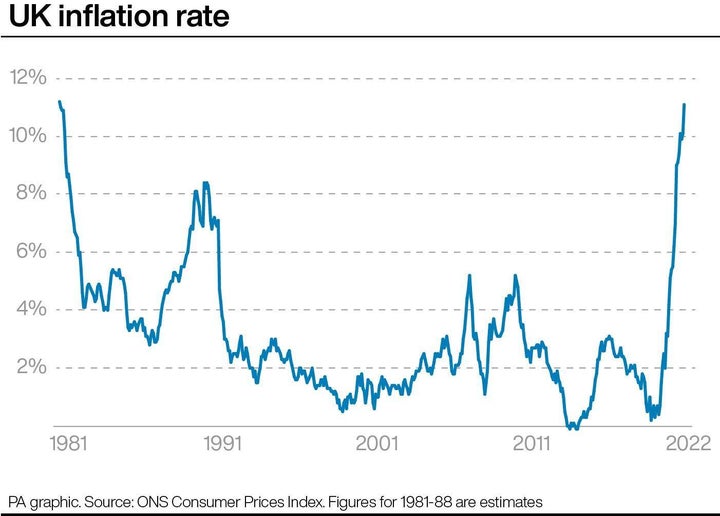
Inflation in the UK reached 11.1% last month, a level not seen since October 1981.
This is according to new data from the Office for National Statistics (ONS).
This means prices for goods and services sold in the UK have crept up to a new high, potentially pushing the country ever closer to that looming recession.
It also comes just a day before chancellor Jeremy Hunt announces his financial statement, where he is expected to unveil higher taxes and public spending cuts.
Here’s what you need to know.
What does a high inflation rate mean?
Inflation is defined as the annual change in prices for a set of goods and services, a way of measuring how quickly prises are rising.
When inflation rates go up, it means the average cost of living increases.
The current inflation rate means a coffee which was previously £1 becomes £1.11 – it may seem a small difference, but when taken into account with all costs, it has a significant impact on your bank balance.
You might also have heard of the famous Goldilocks and the Three Bears analogy to help you understand why inflation is important.
If it’s too low, economic growth is too “cold” and won’t grow. If it’s too high, the economy’s too “hot” and growing too quickly.
The ideal inflation rate is “just right” – much like that third bowl of porridge – and is generally around 2%, give or take one percentage point.

What has caused this surge in prices?
Many parts of the world have struggled in the aftermath of the Covid pandemic, as the world opened up again and demand in energy soared.
Meanwhile, Russia’s invasion of Ukraine has put a strain on those supplies, as the West has sanctioned Moscow and is trying to wean itself off its energy exports.
This is having a knock-on effect both on energy bills and food (food production relies heavily on energy).
While almost every single item increased in price over the last two years, food and energy bills are driving up the overall rate of inflation.
Grocery prices have risen a shocking 16.2%, which is the biggest year-on-year increase since 1977.
The ONS has explained that the largest upward impact came from milk, cheese and eggs.
ONS has also explained that inflation would have been even higher at 13.8%, but for the Energy Price Guarantee from the government.
This is where the Treasury promised the average household would pay around £2,500 per year for energy, even as the wholesale cost of fossil fuels continues to climb. But, this scheme will last just six months.
Gas prices have increased by almost 130% over the last year, while electricity has increased by around 66% – this works out to increasing total household bills by 26.6%.
Even without accounting for food, energy, alcohol or tobacco, inflation was still at 6.5% in October, as all goods and services have become more expensive.
Who is being most affected?
As essential items soar in price, lower-income families are hit the hardest.
For the poorest 10%, the cost of living became 12.5% more expensive.
For the richest 10%, inflation was significantly lower, at just 9.6%.
According to the Resolution Foundation, over-80s are also struggling more, facing inflation rates of around 15.3% during the cold winter months.
The inflation gap between high and low-income households is now the widest since March 2009, when the UK was recovering from the global fiscal crisis.
This disparity is because households with less disposable income spend a greater proportion of their money on food and energy bills.
What about wages?
The average earnings outside of bonuses increased by 5.7% in the year up to September, which is the fastest rate of growth since 2000.
Public sector workers saw their average pay increased by just 2.2%.
These figures show salaries are still trailing behind the current inflation levels, following years of austerity.
It also comes as multiple industries consider strike action over pay, include NHS nurses.
What does this mean for the recession?
A recession is when the economy shrinks for two consecutive quarters, signalling that people are, on the whole, spending much less.
The Bank of England has predicted that the UK will enter a recession lasting into 2024. It may have already begun, after it was confirmed that the economy shrunk by 0.2% between July and September.
Hunt has blamed the ongoing effects of the Covid pandemic and Russia’s war in Ukraine for these inflation numbers.
He called inflation an “insidious tax” which is “eating into pay cheques, household budgets and savings” and warned “tough” decisions were ahead for Thursday’s statement.
As the Bank of England’s job is to control inflation (it has a target rate of around 2%), it’s likely the Bank will increase interest rates, meaning it costs more to borrow money.
Increasing borrowing costs does also mean the UK is more likely to fall into a recession.
When will it go down?
As we move away from the inevitable economic dip, inflation is expected to gradually head back towards the 2% level set out by the Bank of England.
The Bank has predicted inflation will fall in the middle of 2023.
In its website, it explains that this will be driven partly by a slowing in the price rises of energy, due to the Energy Price Guarantee Scheme.
Secondly, it predicts the price of imported goods should stop climbing at such a rate, and there should be less demand for goods and services in the UK.